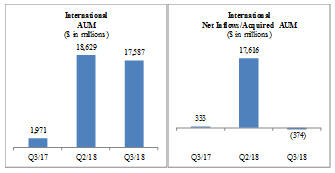Assets Under Management
WisdomTree ETPs
The following chart sets forth the asset mix of our WisdomTree ETPs as of September 30, 2018:

A significant portion of our AUM is held in ETFs that invest in foreign securities. Therefore, our AUM and revenues are affected by movements in global capital market levels and the strengthening or weakening of the U.S. dollar against other currencies. As the chart above reflects, as of September 30, 2018, approximately 19% of our AUM was concentrated in two products with similar strategies – HEDJ, our European equity ETF which hedges exposure to the Euro, and DXJ, our Japanese equity ETF which hedges exposure to the Yen. The strengthening of the Euro or Yen against the U.S. dollar, or the decline in European or Japanese equity markets, may have an adverse effect on our results.
The addition of the AUM of ETFS improves both fund and investment theme concentrations, resulting in a well-diversified mix with immediate scale in commodities and an industry leading position in European listed gold products. These products historically have been negatively correlated with our two largest ETFs, HEDJ and DXJ, and therefore we may experience improved stability of AUM and lower overall AUM volatility. However, we have not recently experienced lower overall AUM volatility and can provide no assurance that the negative historical correlation between the AUM of ETFS and the AUM of our two largest ETFs will be experienced in the future.
As a result of the ETFS Acquisition, our client base has been further diversified with increased exposure to European domiciled investors, commodity focused investors and new-to-firm clients. In addition, our average global ETP advisory fee has declined 0.02, from 0.50% to 0.48% at September 30, 2017 and September 30, 2018, respectively, due to the ETFS Acquisition and change in product mix.
Market Environment
Overview
Performance of the U.S. markets remained robust in the third quarter as the strength of the economy continued to overshadow uncertainty arising from U.S. trade policies toward China and other trading partners. The Japan markets also performed favorably as a weakening of the Japanese yen improved market sentiment, while performance of the European markets was relatively modest. The continued strengthening of the U.S. dollar and rising interest rates weighed on emerging markets and the price of gold.
The S&P 500 rose 7.7%, MSCI EAFE (local currency) rose 2.4%, MSCI Emerging Markets Index (U.S. dollar) declined 0.1% and gold prices declined 5.1% during the third quarter. In addition, the European and Japan equity markets both appreciated with the MSCI EMU Index rising 0.5% and MSCI Japan Index rising 6.5%, respectively, in local currency terms for the quarter. Also, the U.S. dollar strengthened 2.8% versus the Yen and 0.7% versus the Euro during the third quarter.
33




